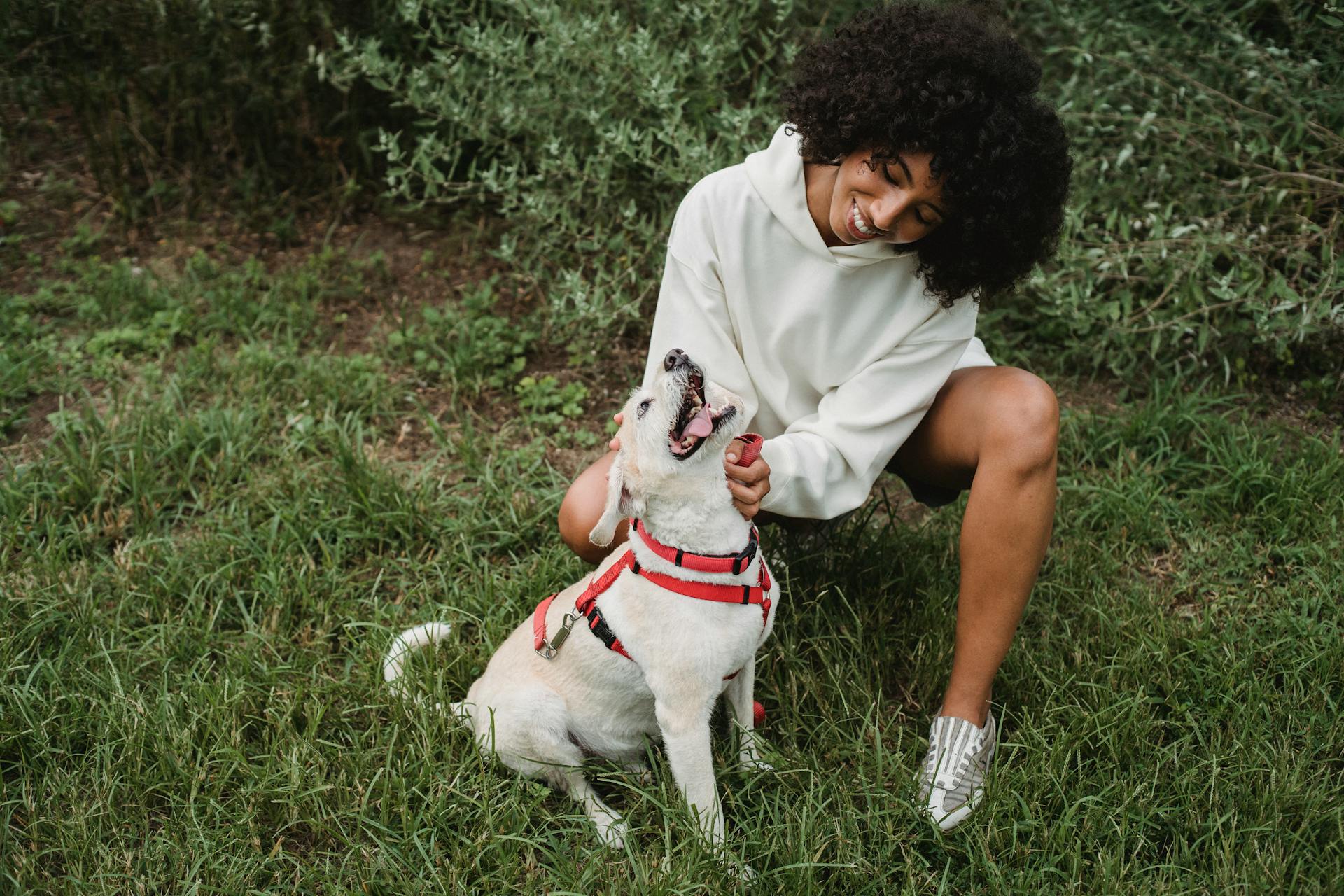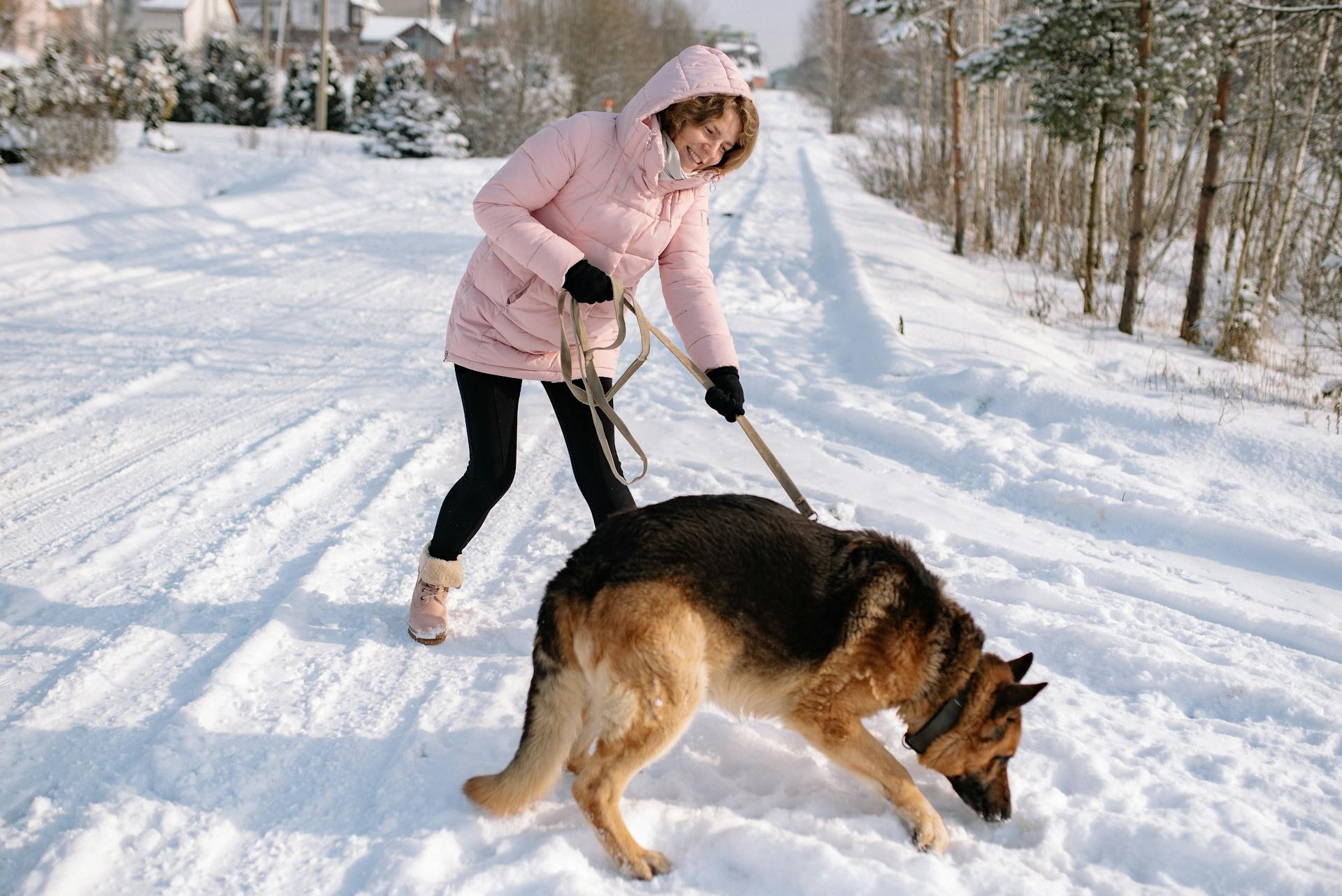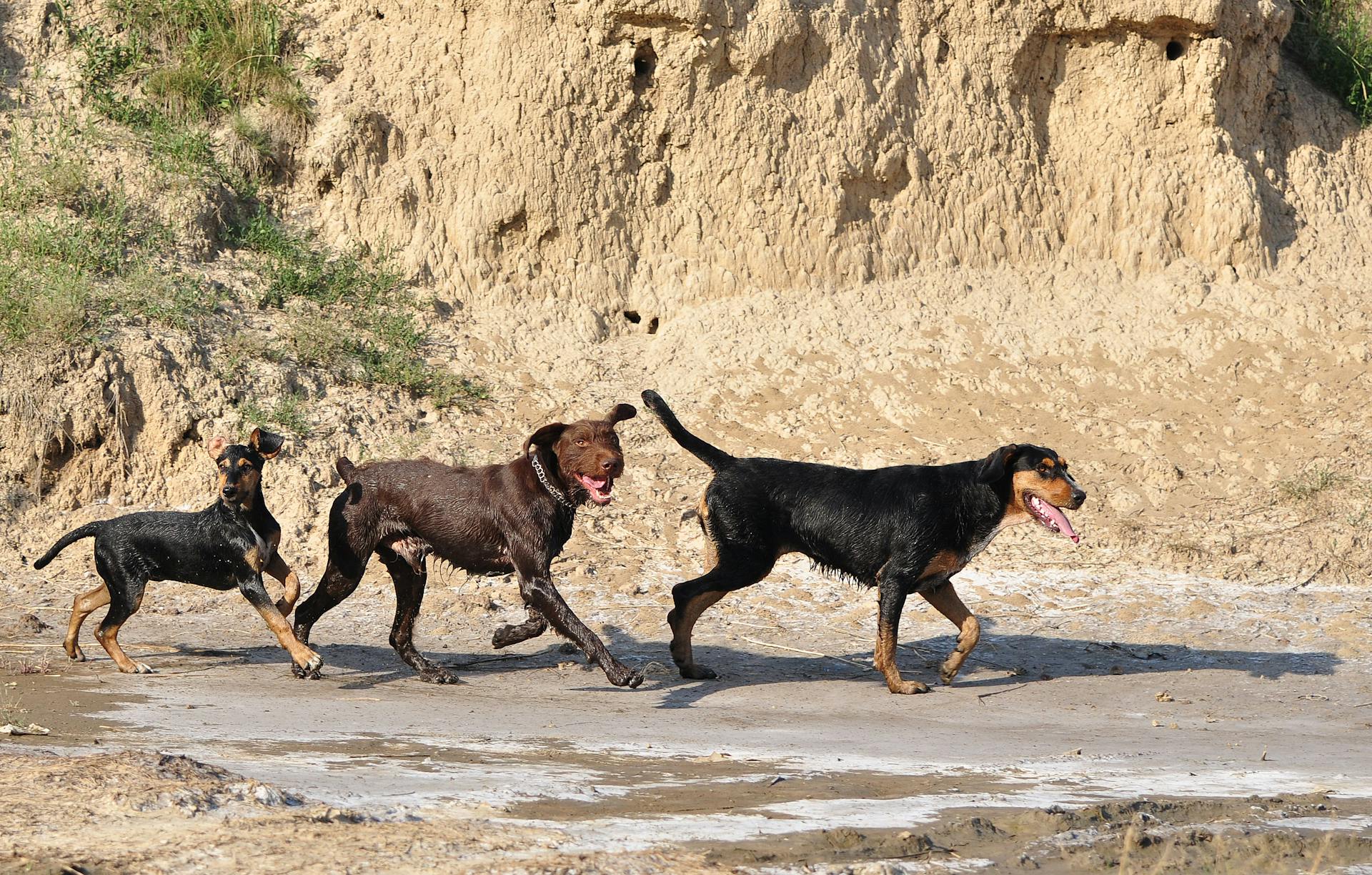
If your horse has a sore foot, there are several things you can do to help. First, check the hoof for any foreign objects that may be causing the soreness. If you find anything, remove it and clean the area. If the soreness is due to an injury, you can apply a cold compress to the area to reduce swelling. You can also try wrapping the foot with a bandage or using a hoof poultice.
If the soreness does not improve within a few days, you should consult your veterinarian. They may recommend additional treatment, such as antibiotics or pain medication. In some cases, surgery may be necessary to correct the problem.
Curious to learn more? Check out: Essential Foot Care for Horses
How can I help my horse if he has a sore foot?
If your horse has a sore foot, there are several things you can do to help him feel better. First, you'll want to check the affected foot for any foreign objects or injuries. If you find anything, you'll want to remove it and clean the wound. If the soreness is caused by an injury, you'll need to consult your veterinarian for further treatment.
Once you've ascertained the cause of the soreness, you can begin to treat it. If the soreness is due to an abscess, you'll need to poultice the foot to draw out the infection. If your horse is shoes, you'll need to have the foot reshod to provide support and protection. If the soreness is due to arthritis, you can try various supplements and treatments to help ease the pain.
No matter the cause of your horse's sore foot, you can help him feel better by providing regular foot care. This includes picking out his feet daily and keeping them clean and dry. You should also check for any sign of discomfort when you handle his feet. If you noticed the soreness early and treated it promptly, your horse should soon be back to his normal self.
For your interest: Rabbit Foot
What are some common causes of foot soreness in horses?
There are a number of different conditions that can lead to foot soreness in horses. The most common cause is usually an injury to the foot or leg, although other conditions such as arthritis or infections can also lead to discomfort. In many cases, the horse may have been working on hard ground or on a surface that was too slippery, which can put undue stress on the feet and legs and lead to inflammation and pain. In some cases, poor hoof care can also lead to foot soreness, as the horse's feet are not being properly protected from the elements or from the wear and tear of daily work. More rarely, foot soreness can be a sign of a more serious condition such as laminitis, so it is always important to seek veterinary advice if your horse is showing signs of discomfort.
A different take: Lead Change
How can I tell if my horse is foot sore?
Your horse's feet are vital to their health and comfort, so it's important to be able to identify when they might be sore. There are a few different ways you can tell if your horse is foot sore.
Firstly, take a look at their stance. If they are standing with their weight on their back legs, or if they are shifting their weight from one foot to the other, this could be a sign that they are in discomfort.
Secondly, observe their gait. If they are limping or favoring one leg, this is another indicator that their feet might be sore.
Thirdly, pay attention to their reaction when you touch or pick up their feet. If they try to pull away or show signs of discomfort, this is a good indication that they are foot sore.
Fourthly, look at the condition of their feet. If they are excessively dry, cracked, or have any open sores, this could also be a sign of soreness.
If you notice any of these signs, it's important to have your horse's feet examined by a veterinarian to determine the cause of the soreness and to start appropriate treatment.
Recommended read: How to Get a Horse's Attention?
How can I prevent my horse from getting foot sore?
If your horse is foot sore, there are a few things you can do to help prevent it. First, make sure that your horse's hooves are properly trimmed and that their shoes fit well. You should also check their feet regularly for any sign of irritation or infection. If you notice anything, be sure to contact your vet right away. Additionally, you can try to avoid hard or rocky surfaces when riding or working your horse. If possible, stick to softer surfaces like sand or dirt. Finally, make sure that your horse gets plenty of rest and has access to a clean, dry place to lie down. If you follow these tips, you can help reduce the risk of your horse becoming foot sore.
For another approach, see: Summer Sore
What are some common treatments for foot soreness in horses?
There are many different types of foot soreness in horses, from minor bruising to serious abscesses and navicular disease. While some cases can be treated at home with simple measures, others will require the care of a veterinarian. Here is a brief overview of some of the most common treatments for foot soreness in horses.
Bruising is one of the most common types of foot soreness in horses. While minor bruises may not require any treatment, more serious ones may need to be wrapped and/or iced. If the horse is lame, he may also need to be rested and/or given non-steroidal anti-inflammatory drugs (NSAIDs) such as Bute or Banamine.
Abscesses are another common type of foot soreness in horses. These are usually caused by bacteria, and can be very painful. Treatment involves draining the abscess and cleansing the area, then wrapping it to keep it clean. The horse may also need antibiotics to clear the infection.
Navicular disease is a serious condition that affects the navicular bone and surrounding structures in the horse's foot. It is often very painful, and can lead to lameness. Treatment typically involves a combination of rest, shoeing, and medication. In some cases, surgery may also be required.
If your horse is experiencing foot soreness, it is important to have him examined by a veterinarian to determine the cause and the best course of treatment.
How long will it take for my horse's foot soreness to heal?
It is impossible to give a definitive answer to the question of 'How long will it take for my horse's foot soreness to heal?' as it depends on a number of factors, including the severity of the soreness, the horse's age and health, the type of terrain the horse is ridden on and how often the horse is ridden. However, there are some general guidelines that can be followed in order to help a horse's sore feet heal.
If a horse has developed sore feet as a result of riding on hard surfaces, it is important to give the horse a break from riding for a few days in order to allow the feet time to recover. The horse should be stabled and given plenty of time to rest; this will help the feet to heal and will also prevent the soreness from becoming worse. If the soreness is severe, the horse may also need to be given pain relief medication in order to make it more comfortable.
Once the initial soreness has subsided, the horse's feet can be gradually introduced to riding again, starting with short rides on soft surfaces such as grass. As the feet continue to heal, the horse can be ridden for longer periods of time and on harder surfaces. It is important to keep an eye on the horse's feet during this process and to stop riding if the soreness reappears.
In most cases, horses with sore feet will make a full recovery and will be able to return to their normal riding schedule within a few weeks. However, it is important to seek veterinary advice if the soreness does not improve or if the horse appears to be in pain.
Here's an interesting read: Sore Hocks
Can I continue to ride my horse if he is foot sore?
Yes, you can continue to ride your horse if he is foot sore, but you will need to take some special precautions. First, you will need to have your horse's hooves trimmed and balanced more often than usual. This will help to take some of the pressure off of his sore feet. You will also need to be careful not to overwork your horse. Make sure to give him plenty of breaks, and don't ride him for too long at a time. If you take these precautions, you should be able to continue riding your horse even though he is foot sore.
Broaden your view: Who Will Help Jack of the Horse?
How can I make my horse more comfortable if he is foot sore?
If your horse is foot sore, there are a few things you can do to make him more comfortable. First, check his hooves for any sign of injury or infection. If you find anything, consult your veterinarian. Second, try to keep your horse's hooves as clean and dry as possible. If his feet are wet or muddy, this can exacerbate any pain he is feeling. Third, provide your horse with plenty of clean, fresh water. This will help to keep his hooves healthy and hydrated. Finally, consider giving your horse a herbal foot soak. This can help to soothe any inflammation or pain he is experiencing.
What are some things I should avoid doing if my horse is foot sore?
If your horse is foot sore, there are some things you should avoid doing. First, avoid riding your horse. If your horse is foot sore, riding will only make it worse. Second, avoid walking your horse on hard surfaces. If your horse is foot sore, walking on hard surfaces will only make it worse. Third, avoid applying any external treatments to your horse's feet. External treatments will not help a foot sore, and could actually make it worse. Finally, avoid doing anything that could potentially irritate or injure your horse's feet. Foot sores are painful, and you don't want to make them worse.
If this caught your attention, see: Wear Riding
Frequently Asked Questions
Can you put boots on a horse with a sore foot?
Yes, but it's not easy. First, the boot needs to be loosened enough so that it can be pulled on over the horse's hoof. Second, the boot must be fitted very snugly or it will rub and cause more pain. Finally, excess padding may need to be cut off so that the boot fits closely around the hoof.
How can I help my horse with foot pain?
Start by reviewing your horse's history, looking for any potential causes of the pain. This could include things like feed and water intake, past injuries, shoeing procedures or hoof care practices. Once you have a good understanding of the problem, try to identify any habitual tendencies that may be contributing to the horse's foot pain. This can include things like grooming patterns or standing habits. Finally, look for ways to improve balance in the horse's feet and implement appropriate treatments. Here are some tips for managing equine foot pain: Trim hooves to proper length so there is balanced contact between coffin bone (on top of foot) and sole. Trim all around hoof wall at least once every six months with a sharp knife so that underlying hoof horn is removed gradually. Brush horses daily; remove excess dried mud and blood using a soft brush. Shoe horses regularly using properly fitted boots that provide cushioning and protection against kicked objects, stones and other hard
Why are my horse’s feet sore?
In farriery, saddle slippage (especially when the horse is sweating), improper nutrition, and use of faulty tack can cause sore feet. Genetics can also play a role in causing foot pain, as well as abnormal bone formation at the hoof zone. Environmental factors that may contribute to foot problems in horses are: weather changes such as increased humidity or rain; exposure to dangerous objects; surface injuries from hauling heavy freight; vaccinations; strenuous exercise during hot weather.
How do you treat soreness and muscle strain in horses?
Soreness and muscle strain can be treated with rest, ice, and a analgesic. Your veterinarian may also recommend physical therapy to help regain range of motion.
How to put boots on a horse?
The boot should fit snugly and overlap the top of the hoof. If there is any extra space, gently push down on the boot with your fingers to make sure it's secure. Thread one end of the laces through the buckle at the front of the boot, pull tight, and then tie a knot in the lace next to where it loops back around. Repeat on the other side.
Sources
- https://www.horseforum.com/threads/should-i-ride-my-horse-with-a-sore-back.759073/
- https://www.flexhoofboots.com/post/foot-sore
- https://secondvet.com/relieving-hoof-and-body-soreness-in-the-horse-effectively/
- https://paulickreport.com/horse-care-category/ouch-foot-sore-horses/
- https://www.horseforum.com/threads/how-do-i-make-my-new-horse-feel-comfortable-and-more.99329/
- https://www.youtube.com/watch
- https://greenpet.com.au/horse-foot-sore/
- https://www.horseforum.com/threads/help-my-horse-has-a-sore-foot.458234/
- https://www.seahorsecorral.org/PosturesOfPain.html
- https://www.caniry.com/how-do-you-know-if-your-horses-foot-is-sore/
- https://thehorse.com/164825/managing-equine-foot-pain/
- https://www.msdvetmanual.com/horse-owners/bone,-joint,-and-muscle-disorders-in-horses/disorders-of-the-foot-in-horses
- https://rideable.org/what-would-happen-if-a-horse-steps-on-your-foot/
- https://www.americanfarriers.com/articles/10683-how-can-i-overcome-foot-sore-issues-with-one-of-my-horses-afjho
Featured Images: pexels.com


